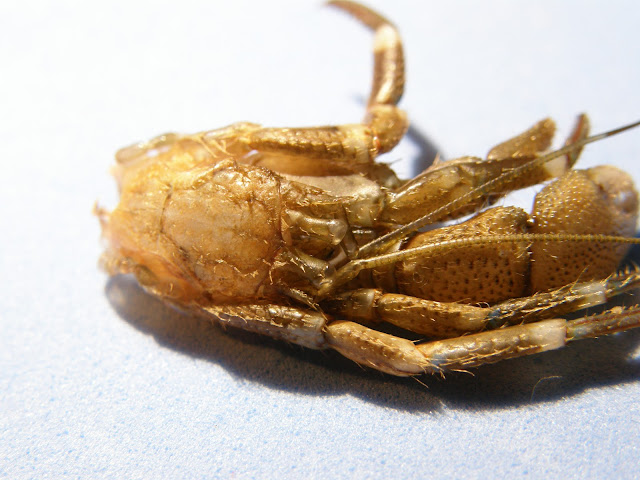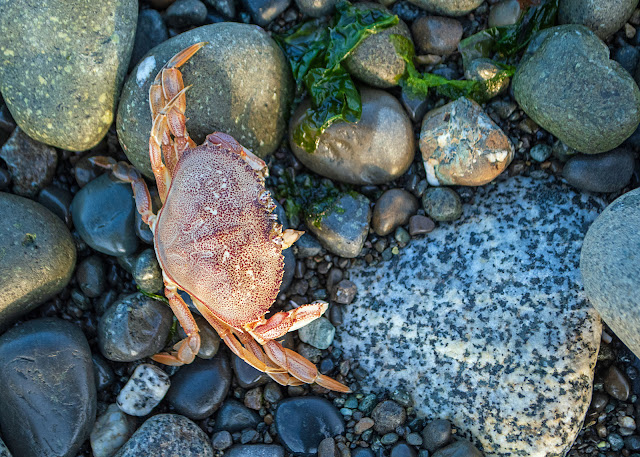A browsing deer, tiptoeing delicately through the thimbleberry patch, hears me coming and stiffens into immobility, a few inches taller already; neck, ears, legs all suddenly stretched. If she thinks I may be a danger, she leaves, bouncing straight-legged through the undergrowth.
A bear doesn't bounce. He shuffles. Like a fat man in baggy trousers, not in any hurry, unconcerned, he plods down a trail. His apparent slowness is deceptive; he's gone behind the trees in a moment.
Range cattle. Heavy. Slow. They stand watching, pondering; should we move out of the way? When they make up their minds, its as if the weight were almost too much for their legs.
Every live thing has its own way of moving. Even when we capture only a glimpse, under the trees, in the undergrowth, half behind the rocks, we can recognize them by their gait.
The same goes for the tiny beasties, the flying, crawling, sliding critters. In a tide pool full of seaweeds, a flash of twisty, splashing movement, gone in an instant, alerts us to the presence of a gunnel; a quick, sharp, straight-line dash into the dark is probably a sculpin. Crabs scuttle sideways, feet first and last. Flatworms ooze like a smear of oil. Anemones caught off guard shrink inwards.
In the aquarium, the crabs dig crab caves. Sliding to the right, dragging sand; slipping quickly back to the left, slightly downhill. Then back dragging sand again. Snails slide along so slowly, then suddenly haul themselves forward with a jerk as they bring their body up to their foot. Hermit crabs, even at rest, are never still; they wave long antennae and bright flag-like antennules constantly. Amphipods are in a continual flutter.
In the wet sand left after I washed off a new batch of eelgrass, a couple of the sand grains were moving. This way, rolling; that way, falling back. Looked like crabs to me, but so, so tiny! The hand lens confirmed it. I gently tipped the sand, with sand-grain crabs into the tank.
I saw them again when I next cleaned the tank, hiding in a corner away from all the activity. Still barely visible. Next, one turned up at the front of the tank, under a rock, excavating his miniature cave. Every time I passed, he was there, busy moving sand one grain at a time.
I found some time and got out the camera with the macro lens and the auxiliary flash, cleaned the glass and sat down to wait for him. And waited. He'd finished making his den, and crab-like, abandoned it to start digging somewhere else, out of sight.
It's all good. I took photos, while I waited, of other tinies.
 |
Young hairy hermit, on section of kelp stipe.
|
 |
The crab's rock. It was covered in barnacles, but the crabs (larger ones) have eaten most of them and now orange-striped green anemones have moved into the empty shells.
|
 |
The same stone. With one of the remaining barnacles out fishing.
|
 |
Eelgrass isopods. Usually they're green; this one, and her babies (look among the red algae beside her) are a dull grey.
|
 |
The kelp crab again. He's lost his sea lettuce cap and added a bit of rockweed.
|
 |
On top of the sand where I was looking for the crab, an amphipod.
|
~~~~~~~~~~~~~~~~~~~~~~
Un venado se mueve tranquilamente entre las hierbas, comiendo hojas de frutillas. Me acerco y se endereza, estirando las orejas y el cuello; parece que ha crecido en ese momento. Ahi se queda, como congelado, una estatua viva. Se le ocurre que yo pueda ser peligrosa y se aleja, saltando con las patas tiesas hasta desaparecer entre la maleza.
El oso no salta. Anda sin prisas, sin urgencia. Se ve como un viejo hombre gordo en pantalones grandes y flojos. Como si no te viera, como que no le preocupes, va holgazaneando hasta esconderse tras unas rocas.
Las vacas que andan libres por las montes. Son pesadas. Lentas. Se quedan paradas, mirándote, pensando; —¿Vale la pena salir del camino? — Se deciden después de un rato, pero es como si su peso fuera demasiado para moverse a prisa.
Cada cosa viva tiene su propio movimiento. Aún cuando solamente captamos un vistazo, una curva, unas orejas, unas ancas peludas, ya debajo de los árboles, entre la maleza, tras las rocas; aun así las podemos reconocer por la manera en que se mueven.
Lo mismo pasa con los animalitos pequeñitos, los que vuelan, se arrastran, corren o nadan en las grietas que pasamos sin mirar. En un charco dejado por la marea, lleno de algas marinas, un movimiento rápido, ondulante, y casi de inmediato detenido nos indica la presencia de un pescadito espinoso de marea. Algo que nada rápidamente, como una flecha dirigida al punto más oscuro probablemente sea una esculpina. Los cangrejos corren hacia un lado, con las patas por adelante y atrás. Los platelmintos (gusanos planos) se escurren como un borrón de aceite. Las anémonas cuando notan nuestra presencia, se encogen y se encierran.
En mi acuario, los cangrejos se hacen cuevas. Se arriman hacia el derecho, jalando y empujando arena consigo, luego regresan sin carga a la oscuridad para recoger más. Los caracoles marinos se deslizan lentamente, y de repente dan un saltito para adelante, trayendo su concha al nivel de la pata. Los cangrejos ermitaños, aun cuando están parados, nunca se quedan quietos. Agitan las largas antenas constantemente, sacuden las banderitas (atenulas) arriba de la cabeza. Los anfípodos vibran continuamente.
Entre la arena mojada que quedó después de lavar un manojo de hierba Zostera, algunos de los granos de arena se movían por si solos. Rodaban para allá, caían para acá. Movimientos de cangrejo, pero ¡tan, tan pequeño! Con una lupa lo confirmé; era un par de cangrejititos. Con cuidado, los vertí en el tanque.
Los vi de nuevo la próxima vez que limpié el tanque, escondidos en una esquina lejos de toda la actividad. Todavía apenas visibles. Luego, uno se presentó en la pared de enfrente del tanque, debajo de una piedra, excavando su cueva miniatura. Cada vez que yo pasaba, allí estaba, ocupado en mover la arena, un grano a la vez.
Cuando tuve tiempo, saqué la cámara con la lente para fotos macro, y el “flash” auxiliar. Limpié el vidrio y me senté a esperar a que saliera mi cangrejito. Esperé. Esperé. No apareció. Aparentemente había terminado de construir su cueva, y a la manera de los cangrejos, de inmediato la abandonó para empezar a hacerse otra, en otra parte.
Total. Todo está bien. No perdí el tiempo. Mientras esperaba, tomé fotos de otras criaturas miniaturas.
Las fotos:
- Un ermitaño pequeño en un pedazo de estipa de kelp.
- La piedra donde el cangrejito había hecho su cueva. La parte superior había estado cubierta de bálanos, pero los cangrejos más grandes los han estado comiendo. Ahora un grupo de anémonas ha ocupado las conchas vacías.
- Otra foto, con un bálano pescando.
- Una isopoda con su cría. Mira entre las algas rojas al su lado.
- El cangrejo kelp otra vez. Ha perdido su gorro de alga verde, y ahora lleva un pedazo de alga amarilla.
- Y en la superficie de la arena, donde buscaba el cangrejito, un anfípodo.


















































